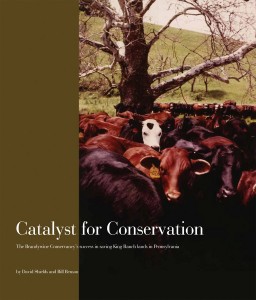Author to sign book about ranch history and aftermath, ‘Catalyst for Conservation’ Sunday

David Shields, a co-author of the book 'Catalyst for Conservation' will speak about the book project and sign copies at Brandywine River Museum Sunday.
Many of the scenic vistas revered by residents in the Unionville area owe their existence to a herd of well-traveled steers and a group of scrappy conservationists who overcame nearly insurmountable odds to preserve the land once occupied by thousands of cattle.
The saga of how the Brandywine Conservancy engineered an unprecedented land-preservation coup is chronicled in the book “Catalyst for Conservation.” In 1984, the conservancy acquired more than 5,000 acres from the Texas-based King Ranch, which had annually shipped its herd eastward to fatten steers on prime Chester County pastures in Newlin, East Fallowfield, East and West Marlborough Townships.
On Sunday, which also happens to be Earth Day, David Shields, a co-author of the book, will discuss the project – a dramatic, decade-long undertaking that frequently threatened to unravel. The 1 p.m. lecture at the Brandywine River Museum will be followed by a book-signing from 1:30 to 3 p.m. The book, which costs $24.95, is available for purchase at the museum or online.
Shields, who began working at the Brandywine Conservancy during the height of the King Ranch project in 1983, participated in many of the events the book describes. His co-author, Bill Benson, offered expertise about the sellers of the Buck and Doe Valley Farms – who lived about 2,000 miles away. Benson had authored a book on Bob and Helen Kleberg, owners of the legendary King Ranch headquartered in Kingsville, Texas, and known as “the birthplace of American ranching.”
According to Conservancy officials, the impetus for the book came during the celebration of the 25-year anniversary of the sale in 2009. Since misinformation about some details of the purchase had periodically surfaced, officials felt a definitive history was needed. After all, the project has served as a conservation model not only in the county but also across the country.
Pristine land, traversed by the Buck and Doe Runs that contribute to Wilmington’s drinking water, could have become a Disney theme park, a sludge deposit for the City of Philadelphia, or a development of 15,526 homes. Instead, residents of the region enjoy unspoiled flora, fauna, historic sites, and unparalleled views. The book provides a primer on how that goal was accomplished – from the transport of cherry-colored cattle to Chester County to the complexities of enticing investors to preserve their former habitat.







